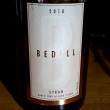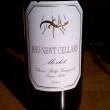Op-Ed: Why NOT Chardonnay? (By Jim Silver, Peconic Bay Winery)

Story and photo by Jim Silver, General Manager, Peconic Bay Winery
I have been around the wine business long enough
(22 years)
to have seen many wine trends and fashions played out in the public
arena:
Australia's incredible rise and stunning fall; Germany's reawakening;
France’s fall from grace; pinot grigio’s leap from obscurity to
most popular import from Europe; California wines at 12.5% and now at
15.5%
alcohol.
There are others of course, but today's topic is that curious
love-hate relationship some of us have with chardonnay.
When I was a young tenderfoot in the wine business, I was fascinated by
the
obscure. New wine enthusiasts often are: They love the
“undiscovered” grape varieties, and the tiny producers in tiny
villages off the beaten track that produce tiny quantities of wine
you've never
heard of. These discoveries were always undervalued and marvelous. There
is no
denying how entertaining this sort of discovery is, especially if you
remember
that it wasn’t too long ago that viognier, albariño, grüner veltliner, malbec and carmenere were all but unknown outside of their hometowns.
And then there’s chardonnay.
Oh! The noble chardonnay! A duchess from
Burgundy, champion white wine of the West, and the true darling of the
1980s and 1990s. Yet chardonnay seem so “five minutes
ago,” like an Oldsmobile or Polaroid camera. Certainly the golden sweet, oaky,
ultra-richness of many chardonnays seems out of date to us today. A
somewhat
sudden change in our desire for this style of wine seems to have had
unintended
consequences for the unfortunate grape that made all of these Reagan-era
“oak bombs.”
Chardonnay, along with its tenderer sister riesling, is the best white
wine
grape in the world to survive, thrive, adapt and relate back to its
master the terroir of the place in which it grows.
In Chablis for example, chardonnay sets its roots into ancient oyster shell beds and reads back
to us
purity and minerality like no other wine in the world. Chardonnay here
reflects
the gray cloudy sky and cold stone cellars of the winery like a mirror
while it
stands pale in the glass — structured, stiff, with a subtle nose and
long flavors — and capable of astonishing longevity.
And still, chardonnay manages to grow almost anywhere it wants,
faithfully
reporting on the weather and winemaking to the taster. On the opposite
side of
the earth, Australian chardonnay returns the inimitably sun-baked warmth
and
red stone soils of that country. Whether on the coast of Sonoma, the
cool
Casablanca slopes, the white hillsides of Champagne, or the sandy
bayside
vineyards of Cutchogue, this grape is a capable actress. All the while,
its
amazing versatility and consistent success protects the considerable
investment
made by the owners of these vineyards.
The twisting of chardonnay's reputation began there — in the economics.
The early 1990s wave of high production wines made from high yielding
vineyards
thwarted the grape's notoriety but did make money for the wineries that
needed
to fill large bottles for large markets at small prices.
Indeed, public
fondness for this wine has not waned — not one bit — in all of that
time. Backlash to its incredible world-wide popularity was inevitable
though;
beginning “pre-Internet” with the abhorrent ABC people (Anything
But Chardonnay) and later, the rise of the Web provided a new outlet for
the chardonnay hater, and lover of the obscure.
Before the rise of blogs, the tiny group of wine writers in print was
largely
protective of chardonnay and its good name. Today, there are literally
thousands of people blogging about wine, the vast majority of who have a
wonderfully bloated estimation of the relevance of their opinions.
I
think
it's probably easy for the new wine enthusiast to attack an easy and
ubiquitous
target like chardonnay but I take issue when the high yield,
mega-production chardonnays are lumped together with real classics! It's
nothing short
of wine
bigotry! Who in their right mind, of even the ABC types, would turn away
from a
Meursault or Montrachet, a Pahlmeyer, a Planeta, or a Taittinger Comte
de
Champagne simply because it was made with the chardonnay grape?
Working alongside Long Island
Chardonnay experts — Greg Gove, winemaker, and Charlie Hargrave,
winegrower -
has
already renewed my great enthusiasm for this variety, as the grape
displays such depth of
character, and
remarkable complexity and longevity at Peconic Bay Winery.
What I have learned about New York State chardonnays is that
we consistently fail when we try to be something we are not, and
frequently succeed
where the terroir (and acidity and fruit) is allowed to shine through.
To
the
ABC crowd, I say, “Why not Chardonnay?” Rediscover a classic — and find
room in your collection for one of the earth’s greatest
messengers.















I agree completely. Too often trends dictate what people drink and thats a shame. Great post Jim!
Thanks for the contribution, Jim. I know it’s been a long time coming and has been in your head for some time.
When we’re talking classic Burgundy/Chablis, only a fool would say chardonnay has no place. That’s just silly.
My biggest problem with chardonnay (and I’m talking largely NY here because I drink so many of these wines) is that many are made in a middling style that isn’t committed to either the minerally, fresh (let’s call it Chablis-style for sake of argument)or the rich, but balanced (let’s call it Burgundian for sake of argument).
To often they are somewhere in the middle — maybe oakier, but thin….and in the end, many local chards are very very similar. There’s little that is distinct or special about them even among the local options, let alone in the larger market.
One example I often use (and your two chardonnays would probably fit this as well) are two of the chardonnays made at Channing Daughters — the all-steel Scuttlehole and the wild ferment, funky complex L’Enfant Sauvage.
With these two wines, Chris Tracy (the winemaker) has committed to these two varying styles and goes after them with gusto. They ARE distinctive and I happen to enjoy both quite a bit.
I guess this is a long way of me saying that I’m not anti-chardonnay (which I’ve been accused of)…I’m just anti-ubiquitous chardonnay — from ANY region.
There is obviously a lot of chardonnay planted in New York, because it’s adaptable and can grow in a wide array of climates and in different soils. I just wish that more wineries did more interesting things with it.
Your response is well received here Lenn. In the case of Chardonnay, the wine producers too often are trying too hard to create what they perceive is the ideal consumer’s wine. They bend the grape to fit into a preconceived ideal based on economics and fashion.
I think you see a more successful Chardonnay produced when the winery knows what it wants to be before they think of the consumer, or trends, or fashions.
When terroir, natural and limited intervention-ist winemaking is allowed to thrive, the wine is just better for it. There’s more than enough consumers for THAT type of wine. No matter what its made of.
My point all along is that great Chardonnay is greater than just about anything else (with the possible exception of great Riesling.)
Jim -
Stirring, provocative stuff. Outstanding. In particular, the section on Chablis was gorgeously composed and astutely accurate. I will never forget my first experience with Chablis. It was in a blind tasting, and I was thrilled with the wine - though my assumptions were a multiverse away from Chardonnay. That was the moment when I realized my general disinterest with Chardonnay was threatening to cause me to miss the best.
But I think you touched on an important point - perhaps the most important with Chardonnay. The very best is so, so far superior to the everyday stuff that it is hardly recognizable as related. So yes, you are right to point out that some engage in Chardonnay bigotry, but I won’t deny my own general - and continuing! - disinterest with Chardonnay. I’d like to think my disinterest is commensurate with a disinterested winemaker, carelessly cranking out Chardonnay because it’s simply expected.
I do not thrill to most Chardonnays. I don’t expect that to change. But to Chablis and its ilk, I will always warm to the opportunity. Cheers on a tremendous post.
When the world “discovers” high quality NY wine, Chardonnay will be near the top of the list of varieties that excel in this state. I love NY Chardonnay!
Nice job of writing Jim and I happen to agree with you. Chardonnay has been the victim of the same malaise that beset Merlot - the California winemaking philosophy.
I also agree with your assessment of Chablis - it is some of the most wonderful and interesting white wine in the world. Long Island has made great strides in identifying the correct style for local Chard - eschewing excess oak and letting the fruit shine through - but we can continue to improve with this grape. Longer hang time, better clones, warmer fermentation and indigenous yeast need to be explored further. Also I’m convinced the older our vines get the more complex our wines will become. Like Merlot, it grows really well in our climate and will continue to make some of the region’s best wines for many years to come. I know PBW will be one of the producers leading the way.
I think that’s a great point. New York isn’t California, and I don’t think Finger Lakes fruit handles excess oak or malo like Kendall Jackson Chardonnay can. IMHO, some of the best Chardonnay in the Finger Lakes are often not the more expensive “reserve” bottlings.
Prejean makes a very nice Chardonnay that can be had for $8 and so does Standing Stone. Plus, they are around 12% alcohol. Talk about food-friendly!!